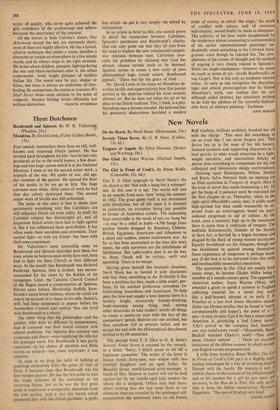Three Dutchmen
Rembrandt and Spinoza. By W. R. Valentiner. (Phaidon, 21s.)
JUST outside Amsterdam there lives an old, well- known and respected Dutch painter. He has worked hard throughout his life—but he has only produced, as far as the world knows, a few draw- ings and one large canvas which is in the National Museum. I went to see his second major work, a triptych of the war. We spoke of war, old age, the vocation of the painter. He opened the door of his studio to let me go in first. The huge canvases were white. After years of work he had that day calmly destroyed them. The second major work of his life was still unfinished.
The point of this story is that it shows how persistently something very like Calvinism can still influence Dutch art even today. In itself the Calvinist religion has discouraged art, and all important Dutch artists have had to fight against it. But it has influenced them nevertheless. It has often made them moralists and extremists. Their central fight—as with my friend—has been with their own consciences.
Mr. Valentiner's most interesting essay on Rembrandt and Spinoza describes how these two men, whom he believes must surely have met, both had to tight the State Church in their different ways. In the month that Rembrandt was declared bankrupt, Spinoza, then a student, was excom- municated for his views by the Rabbis of his synagogue. Later, the Calvinist Church Council at the Hague issued a condemnation of Spinoza. Eleven years before, Hendrickje Stoffels, Rem- brandt's much-loved mistress, whom he could not marry on account of a clause in his wife, Saskia's, will, had been summoned to appear before the Amsterdam Council and confess `that she lived with Rembrandt as a whore.'
The other thing that the philosopher and the painter, who were so different in temperament, had in common was their moral concern with ethical problems. For Spinoza this concern was conscious and direct—even supplying the title for his principal work. For Rembrandt it was partly conscious—in his choice of parables and Bible stories as subjects—but, more important, it was intuitive.
As soon as we drop the habit of looking at paintings exclusively from the point of view of form, it becomes clear that Rembrandt was the first modern painter. He was the first artist to take the tragic isolation of the individual as his recurring theme, just as he was the first great artist to experience a comparable alienation from his own society. And it was this theme which presented him n with his ethical problem : a prob-
lem which—to put it very simply—he solved by compassion.
In an article as brief as this, one cannot prove in detail the connection between Calvinism, Spinoza's pantheism and Rembrandt's charity. One can only point out that they all rose from the need to explain the new commercial-competi- tive relations between men. Calvinism over- rides the problems by claiming that God has already chosen certain souls to be damned. Spinoza strives to create a new unity of pure philosophical logic round nature. Rembrandt appeals: 'There but for the grace of God . .
Mr. David Lewis in his essay on Mondrian de- scribes lucidly and appreciatively how this painter arrived at the doctrine behind his most severely abstract art. But he does not relate his art or his ideas to the Dutch tradition. This, I think, is a pity. Mondrian was a fervent moralist. He believed that his geometric abstractions heralded a modern order of society, in which 'the tragic,' the result of conflict with nature, and of excessive individuality, would finally be made to disappear. The auslerity Of his later works (emphasised by the tenderness almost amounting to sentimentality of his earlier representational paintings) un- doubtedly owed something to his Calvinist back- ground—even though he rejected this. The com- pleteness of his system of thought and his method of arguing is very closely related to Spinoza's. While his single-mindedness—however we assess its result in terms of art—recalls Rembrandt's or van Gogh's. Nor is this only an academic interest today. As soon as one recognises the discipline, logic and ethical preoccupation that lie behind Mondrian's work, one realises that his art, although called abstract, has absolutely nothing to do with the nihilism of the currently fashion- able form of abstract painting—Tachisme.
JOHN BERGER


































 Previous page
Previous page